What is Jordanian food?
Jordan, due to its geographical location in the Levant, has culinary influences from North Africa, the Middle East, Persia, and the Mediterranean. So while technically ful medames might be originally from Egypt, it is also extremely common and popular locally in Jordan as well.
this list of Jordanian food, might not be every dish that originates or was discovered in Jordan, but it’s a list of food that you’ll find commonly throughout Jordan.
Falafel
Falafel, a combination of ground chickpeas, mixed with a variety of spices, then deep-fried into a mini patty like shapes, is one of the most common street food snacks or light meals in Jordan. They can be eaten on their own like veggie nuggets, eaten with bread, or stuffed into sandwiches.

Moutabel
Moutabel is a dip like hummus, but it is a completely different experience. Like hummus, moutabel is regularly found on nearly every Middle Eastern table. You may be familiar with a form of this dish known by another name, babaganoush. Moutabel is made from roasted eggplant and tahini. Extra flavor is blended in with ingredients that can include garlic, lemon juice, hot peppers or pomegranate seeds.
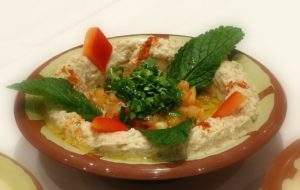
Hummus
Hummus is a Levantinedip or spreads made from cooked, mashed chickpeas or other beans, blended with tahini, olive oil, lemon juice, salt, and garlic. It is popular in the Middle East and the Mediterranean, as well as in Middle Eastern cuisine around the globe.
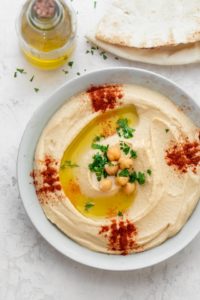
Labneh
Labneh, which is also known as strained yoghurt, is a very thick, creamy yoghurt, that’s served at just about every breakfast table in Jordan. It’s not typically eaten like a bowl of yoghurt because it’s so rich, but instead it’s used as a spread for bread, or a dip for vegetables. The taste is sour and creamy, but usually not salty, very similar to sour cream.
Labneh can be served in a bowl plain, or drizzled with olive oil, or combined with different herbs or leaves to give it more flavor.
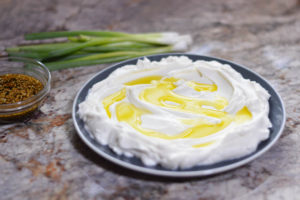
Galayet Bandora
This dish includes tomatoes which are stewed until soft and pureed, with a few seasonings like garlic, olive oil, and salt. The tartness and sweetness of the tomatoes are what really shines, and it tastes great scooped up with bread ore eaten with rice.
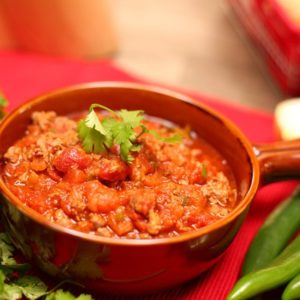
Chicken Liver
Chicken Liver
Commonly served as a mezze dish, along with dishes like hummus and moutabel, chicken livers are another fantastic Jordanian dish to complement your meal. The chicken livers are typically sautéed in olive oil with just a few simple seasonings like garlic, parsley, and salt, and then sprinkled with some lemon juice.
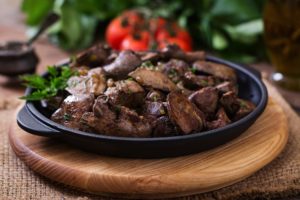
Tabbouleh
Another Levantine dish, often a starter or salad, tabbouleh is a mixture of finely minced parsley, tomatoes, garlic, and bulgar wheat, all dressed in lemon juice, salt, and olive oil. Tabbouleh is not typically scooped up with bread like hummus or moutabel, but it’s typically eaten plain with a spoon.
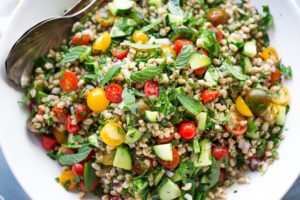
Arabic salad
Similar in dressing taste to tabbouleh, but with a different vegetable make-up, Jordanian, or Arabic salad, usually includes finely diced up cucumber, tomatoes, and bell peppers, dressed in lemon juice and lots of olive oil. Arabic salad makes an excellent refreshing starter dish, or it served with main dishes like maqluba (rice and meat) and with grilled dishes like shish kebabs – to give the meal a nice balance.
Arabic salad makes an excellent refreshing starter dish, or it served with main dishes like maqluba (rice and meat) and with grilled dishes like shish kebabs – to give the meal a nice balance.
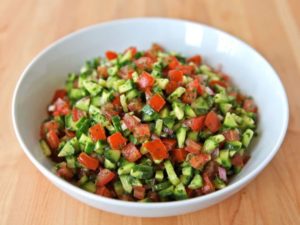
Fattoush
Tomato, cucumber, lettuce, and radish with toasted pitta bread croutons and dressing of tangy sumac, mint, parsley, lemon, garlic, olive oil, and vinegar. Crunchy and piquant our favorite salad.

Rocket salad
Big peppery rocket leaves simply dressed with lemon and olive oil.
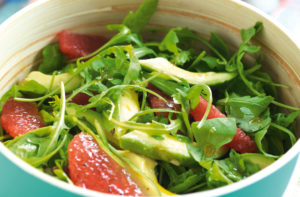
Stuffed Grape leaves and zucchini
Warak enab, or stuffed grape leaves, and kousa mahshi, which are stuffed zucchini, can sometimes be served together, and they are another fantastic addition to Jordanian cuisine. Versions of this dish are commonly eaten throughout the Middle East and the Mediterranean.
Both the grape leaves and the zucchini are stuffed with a combination of rice and ground meat, onions, and light seasonings, then wrapped up, and slow-cooked.
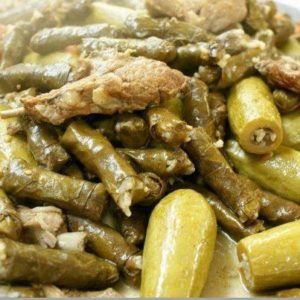
Shawarma
A meat lovers favorite from Europe to the Middle East, shawarma is common in Jordan and you’ll find restaurants that serve lamb, beef, and chicken versions. The signature method of cooking shawarma – layers of thin meat stacked on a sword-like spit and revolving either vertically or horizontally over a source of heat – is part of what gives the meat its unique taste. When the outer layer of meat is cooked, it’s shaved off with a sharp knife, and usually wrapped in bread with either garlic sauce or tahini and a few pickled vegetables.
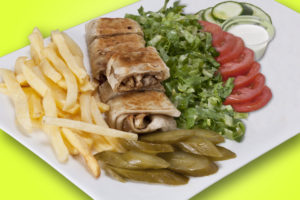
Musakhan
Musakhan is a Jordanian and Palestinian dish of slices of bread, chicken, heaps of onions, fragrant spices like allspice and cinnamon, and lots of olive oil. The ingredients are stewed together until the onion, chicken, olives, and bread are fall-apart tender and the spices have blended and harmonized. While the spices have a sweet tinge to them, the actual dish is not sweet.
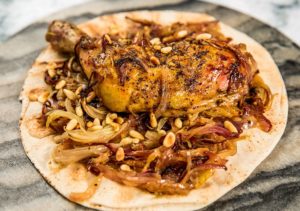
Maqluba
Along with mansaf, maqluba is another one of the favorite Jordanian dishes. Literally translated at upside down, maqluba includes meat or chicken on the bottom, rice, and spices, all cooked together in one pot. Once the dish is ready, the pot is flipped over onto a big plate or communal tray, so the rice stays on the bottom, and the meat or chicken is left on the top. Maqluba can be garnished with parsley, fried pine nuts or other types of nuts, and slices of lemon.

Mansaf
There’s one Jordanian food that is without question one of the most beloved dishes in the Kingdom – a dish that has known to bring people together in harmony and has even been at the center of resolving conflict. That dish is none other than Jordanian mansaf, widely considered to be the national dish of Jordan. There are three main components to mansaf: rice, lamb, and jameed. The jameed, which is a hard dried out and fermented goats milk yogurt, is re-hydrated into a gravy and used to pour over the rice and lamb. The rice and lamb are fantastic, but the mansaf really shines because of the jameed, which has a sour and salty taste, and an undeniable goat flavor. When you eat a ball of mansaf, you can literally taste the land of Jordan in your bite – it’s amazing.
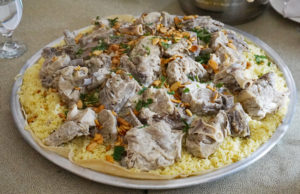
Zarb
Similar to a Polynesian underground meat roast, the Jordanian Bedouin version of an underground oven is known as zarb. A mix of meat like lamb and chicken, rice, onions, and carrots, are placed in a square hole in the ground, which is filled with flaming hot coals. The hole is then covered with a few layers of blankets to hold in the heat and finally sand is covered over the oven.
After a few hours, the meat and rice are all smoked, steamed, and grilled, all at the same time. The result is meat that’s fall-apart tender.
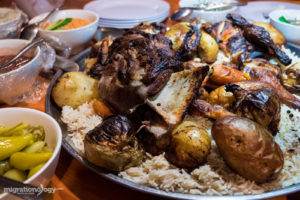
Shish Kebabs
Popular across the Middle East and the Levantine, shish kebabs in Jordan are typically made from minced lamb, which is mixed with parsley and lots of salt, then molded onto big sword-like skewers, and grilled over hot charcoal. The saltiness of the meat and the ratio of meat to fat ensures the maximum of grilled flavor gets packed into the kebabs.
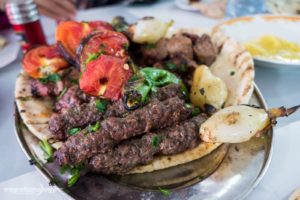
Kofta Bi Tahini
Kind of similar to shish kebabs, just in a completely different form, kofta bi tahini is a dish that includes a bottom base layer of minced kebab (or kofta) meat, flattened out into a patty, topped with thin slices of potato, doused in a thick tahini sauce, and then baked.
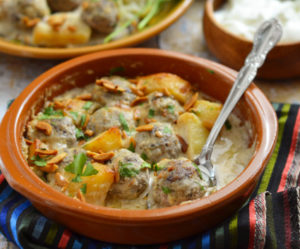
Hareeseh
One of the many common and widely available Arabic desserts in Jordan is hareeseh, a sweet made with semolina, coconut, cream, sugar, yogurt, and almonds, all baked until golden brown. Hareeseh is prepared in bar form, kind of like the size and density of a brownie (although nothing like it in taste). It’s a very sweet dessert and has a slight floral taste to go with the grainy texture of the semolina.

Kanafeh
This dessert is popular throughout the Levant, especially known in Palestine and Jordan. Cheese is the most noticeable of ingredients in kanafeh, which is paired with either noodles or semolina, drenched in sticky rose-scented syrup, and topped with a pinch of ground pistachios. The cheese on the bottom tastes similar to mozzarella, while the top crust is crunchy and gooey.
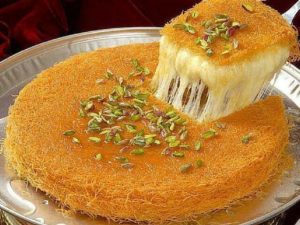
Baklava
Baklava is a rich, sweet dessert pastry made of layers of filo filled with chopped nuts and sweetened and held together with syrup or honey. It is characteristic of the cuisines of the Levant and the broader Middle East, along with the Caucasus, Balkans, Maghreb, and Central Asia.
